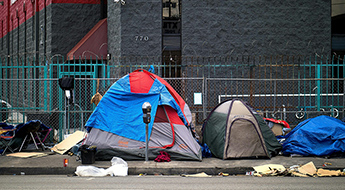The Economy and Pandemic Are Improving, Mental Health Is Not
Young adults have been hit the hardest with depression
Get all our news
This is sobering news and likely reflects that young people are already dealing with much uncertainty at that stage of life; the pandemic thrown in exacerbates that.”
James Druckman
IPR political scientist

With vaccination rates increasing and states reopening, many are hopeful that the pandemic is finally nearing its end. Despite the optimism around the pandemic’s progress, a national survey conducted by researchers from Northwestern, Harvard, Northeastern, and Rutgers finds that depression and other mental health issues have not improved since the winter.
Previously, the researchers have shown that mental distress is closely tied to poor economic conditions, so one would expect to see improvements as the economy improved.
Instead, of those surveyed, over a fourth (28%) meet moderate levels of depression that would result in evaluation and treatment. While the numbers have slightly decreased from 30% in December 2020, depression rates are three times the levels before the pandemic.
The survey of over 21,000 individuals between April 1–May 3 reveals that young adults between the ages of 18 and 24 have been hit particularly hard, with 42% showing signs of at least moderate depression. Individuals from 25–44 years old (32%) and 45–65 years old (20%) have the next highest levels of depression. Only 10% of respondents 65 or older meet criteria for moderate or higher levels of depression. In the researchers’ October 2020 survey, nearly half of young adults reported having at least moderate symptoms of depression.
“This is sobering news and likely reflects that young people are already dealing with much uncertainty at that stage of life; the pandemic thrown in exacerbates that,” IPR political scientist James Druckman said, who co-authored the report.
As with other issues seen during the pandemic, including COVID-19 cases, testing availability, and vaccine hesitancy, mental health varies by demographic group. Parents with children at home have elevated rates of depression (35%) versus adults without children (25%). Adults without a college education report higher levels depression (30%) than adults with a college degree (23%). And individuals earning less than $30,000 per year have the highest levels of depression (35%) compared to other earners.
One interesting finding is that when they are asked about vaccine status, respondents who are moderately to severely depressed are less likely to have been vaccinated (51%) compared to those who have been vaccinated (32%).
“This likely reflects a sense of control over uncertainty among those vaccinated,” Druckman said.
Among racial and ethnic groups, Latino respondents had the highest rates of depression at 33%, with 27% of White and Black respondents reporting depression. Asian Americans, who had the lowest depression rates earlier in the year, saw them increase from 22% to 27% since March 2021.
Political party is closely associated with reports of depression, with about a third of Democrats (30%) and Independents (33%) meeting the criteria for depression versus about one-fifth of Republicans (21%).
Across states, residents in Texas, West Virginia, Alabama, Oklahoma, and Alaska have the greatest rates of depression (33%–34%), and residents in another 11 show more moderate rates of 30% or more. Residents in Illinois reported a depression rate of 28%.
Read the complete report here.
James Druckman is the Payson S. Wild Professor of Political Science and IPR Associate Director. Previous surveys can be found here.
Photo credit: iStock
Funding for the reports came from the National Science, Knight, and the Russell Sage foundations. Data collection was partially supported by Amazon. Any opinions, findings, and conclusions or recommendations expressed in the studies are those of the authors and do not reflect the funders’ views.
Published: May 21, 2021.


